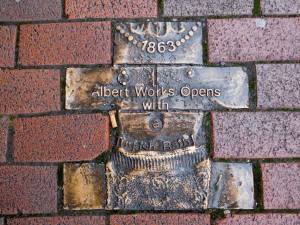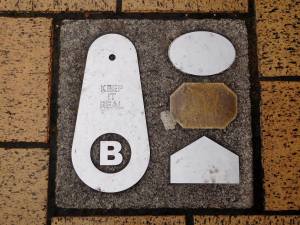 Two final reviews for the year – of course, I’ve now got a few hours of 2016 left with no book started as I don’t like to be untidy, but there you go. Hope everyone’s had a good reading year, I’ll be doing my roundup and TBR photo tomorrow, and until then, I’ll leave you with two reviews of books connected with Modernist writers, the outcome of my competition to pass along the set of Richardsons and an offer to share one of the books reviewed here.
Two final reviews for the year – of course, I’ve now got a few hours of 2016 left with no book started as I don’t like to be untidy, but there you go. Hope everyone’s had a good reading year, I’ll be doing my roundup and TBR photo tomorrow, and until then, I’ll leave you with two reviews of books connected with Modernist writers, the outcome of my competition to pass along the set of Richardsons and an offer to share one of the books reviewed here.
Carol Watts – “Dorothy Richardson”
(29 October 2016, Buxton)
Quite a hard book on the author whose “Pilgrimage” series I have of course been working through this year, which purposefully doesn’t set out to match biographical details to the novels, but instead looks at memory, relates the books to a separate short story called “The Garden” and talks a lot about the relationship of the books to the world of the cinema, which I can see, even though Richardson never mentions the cinema in the books, with all the tracking shots and changes in focus, etc.
There were some good finds in this short volume – as well as herself cutting up five volumes of Proust and reading them in a random order, Richardson apparently advocated reading “Pilgrimage” from a random starting point! There is a lot of meat in this but it was maybe a little academic for me. I do feel compelled to read the autobiography; not sure if I can face the semi-fictionalised book about her as I’m not usually keen on that sort of thing.
If you would like to read this book … As there have been a few of us reading “Pilgrimage”, I’d like to share this book about it. If you’d like to join a book ray for the book (so you will undertake to read it and post it on; it’s 90 pages long and will probably go Large Letter in the UK) then please post a comment and I’ll put a list of email addresses in the front cover and send it out.
*We have a winner* Winner of the full set of “Pilgrimage” books, chosen by random selection (numbers in a hat) is Dee! I will get in touch for your address. Of course you might like to circulate them among all three of you who entered the comp!
Virginia Woolf – “The Years”
(25 December 2016 – from Belva, my LibraryThing Virago Group Not So Secret Santa)
How fortuitous to receive this book just when I wanted to read it to round off #Woolfalong! It would make my top ten of the year easily were it not for the glaring anti-Semitism – I know it’s of its time etc. and expresses what people were thinking but it did make me pause.
But anyway, I got totally absorbed in this family saga running from 1880 to the late 1930s. It’s not nearly as experimental as “The Waves“, read earlier this month, although, as we’ll see, it’s far from being traditional. The middle generation are seen as they age from being a set of anxious children with an ailing mother to prosperous – on the whole – elderly stout folk, but the events and attitudes of the age undermine the paterfamilias, who is found to have feet of clay, and the central character, Eleanor, one of those spinsters who has lived for everyone else and not herself finds a new life of travel and maintains a gay best friend, and women move from father-funded and mocked philanthropy to independence, rooms of their own and careers.
I felt my assessment of this book as a “Forsyte Saga” with more on women’s rights and people’s feelings and better descriptions, or a “Pilgrimage” that you could actually understand and follow (there’s even a Miriam on one of Eleanor’s committees!) was a bit shallow, but the introduction to my (Wordsworth Classics) copy does in fact compare it to Galsworthy. But although it seems like a return to the standard novel in some ways, the ebb and flow of repeated memories, totem objects and thoughts is all Modernism and reminded me of “The Waves” to an extent. It’s moving, too, how episodes of childhood remain with the middle-aged and elderly and an object is given, ages, wears out, is discarded and is rescued by the servant.
Compulsive reading and an excellent finale to the year and to my participation in #Woolfalong.
—
Still to come tomorrow, State of the TBR, Christmas Book Pile, round-up of my reading stats, Top 10 books of the year and plans for book challenges for 2017. Happy New Year, everyone! And don’t forget to comment if you’d like to read “Dorothy Richardson”!

 In my
In my 
















 Working from home, which some of this blog is still about, can mean flexibility, and that flexibility can mean taking random best-friend-days off work – hooray! Last Monday, Emma, who I’ve known for over half my life, came up from London for the day. She’s been part of the Project 365 photography group I’m in this year, and has been busily photographing the Spitalfields Roundels for that, so suggested we had a go at the Jewellery Quarter Pavement Trails on our day together. I’d seen a few of these in the pavement and I’m always up for a slightly geeky challenge, so off we went.
Working from home, which some of this blog is still about, can mean flexibility, and that flexibility can mean taking random best-friend-days off work – hooray! Last Monday, Emma, who I’ve known for over half my life, came up from London for the day. She’s been part of the Project 365 photography group I’m in this year, and has been busily photographing the Spitalfields Roundels for that, so suggested we had a go at the Jewellery Quarter Pavement Trails on our day together. I’d seen a few of these in the pavement and I’m always up for a slightly geeky challenge, so off we went.





























 Lots of people have been doing this and so I thought I would, too. The idea is to take the first line of the first blog post of each month and put them all in one post. Because my actual first post of the month is always a State of the TBR one, I’ve included that for the picture of my waxing and waning (OK, waxing) TBR and then the first sentence of my first review post. So the month name links to the blog post and you get a photo of the TBR for that month (watch that big Kynaston book move up the list as the months wear on …).
Lots of people have been doing this and so I thought I would, too. The idea is to take the first line of the first blog post of each month and put them all in one post. Because my actual first post of the month is always a State of the TBR one, I’ve included that for the picture of my waxing and waning (OK, waxing) TBR and then the first sentence of my first review post. So the month name links to the blog post and you get a photo of the TBR for that month (watch that big Kynaston book move up the list as the months wear on …).










 Well, I have finished Dorothy Richardson’s “Pilgrimage” sequence and right on time, too. The 13 volumes have taken me 13 months to read, and I could not have done it without having the other lovely bloggers and LibraryThing Virago Group members to see me through.
Well, I have finished Dorothy Richardson’s “Pilgrimage” sequence and right on time, too. The 13 volumes have taken me 13 months to read, and I could not have done it without having the other lovely bloggers and LibraryThing Virago Group members to see me through.
Recent comments